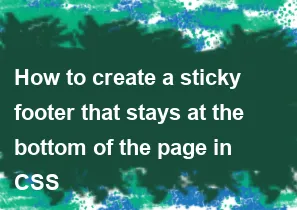How to create a sticky footer that stays at the bottom of the page in CSS

Creating a sticky footer that stays at the bottom of the page in CSS can be achieved using a combination of Flexbox or Grid layout and CSS positioning. Here's a basic example using Flexbox:
html<!DOCTYPE html>
<html lang="en">
<head>
<meta charset="UTF-8">
<meta name="viewport" content="width=device-width, initial-scale=1.0">
<title>Sticky Footer</title>
<style>
html, body {
height: 100%;
margin: 0;
}
body {
display: flex;
flex-direction: column;
}
.content {
flex: 1;
/* Add your main content styles here */
}
.footer {
background-color: #333;
color: #fff;
padding: 10px;
text-align: center;
/* Sticky footer styles */
position: sticky;
bottom: 0;
}
</style>
</head>
<body>
<div class="content">
<!-- Your main content goes here -->
<p>This is your main content.</p>
</div>
<div class="footer">
<!-- Footer content goes here -->
<p>This is the sticky footer.</p>
</div>
</body>
</html>
In this example:
- The
htmlandbodyelements are set to a height of 100% to ensure that the container takes up the full height of the viewport. - The
bodyis set to a flex container with a column direction, allowing the content to flexibly take up available space. - The
.contentdiv hasflex: 1, which means it will take up the available space and push the footer to the bottom. - The
.footerdiv is styled with a background color, padding, and positioned asstickywithbottom: 0, ensuring it sticks to the bottom of the viewport when the content is not tall enough.
Adjust the styles and content to fit your specific needs.
-
Popular Post
- How to optimize for Google's About This Result feature for local businesses
- How to implement multi-language support in an Express.js application
- How to handle and optimize for changes in mobile search behavior
- How to handle CORS in a Node.js application
- How to use Vue.js with a UI framework (e.g., Vuetify, Element UI)
- How to configure Laravel Telescope for monitoring and profiling API requests
- How to create a command-line tool using the Commander.js library in Node.js
- How to implement code splitting in a React.js application
- How to use the AWS SDK for Node.js to interact with various AWS services
- How to use the Node.js Stream API for efficient data processing
- How to implement a cookie parser middleware in Node.js
- How to implement WebSockets for real-time communication in React
-
Latest Post
- How to implement a dynamic form with dynamic field styling based on user input in Next.js
- How to create a custom hook for handling user interactions with the browser's device motion in Next.js
- How to create a custom hook for handling user interactions with the browser's battery status in Next.js
- How to implement a dynamic form with dynamic field visibility based on user input in Next.js
- How to implement a dynamic form with real-time collaboration features in Next.js
- How to create a custom hook for handling user interactions with the browser's media devices in Next.js
- How to use the useSWRInfinite hook for paginating data with a custom loading indicator in Next.js
- How to create a custom hook for handling user interactions with the browser's network status in Next.js
- How to create a custom hook for handling user interactions with the browser's location in Next.js
- How to implement a dynamic form with multi-language support in Next.js
- How to create a custom hook for handling user interactions with the browser's ambient light sensor in Next.js
- How to use the useHover hook for creating interactive image zoom effects in Next.js